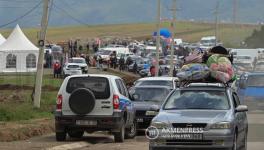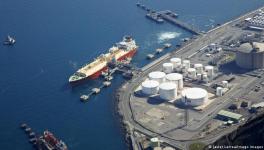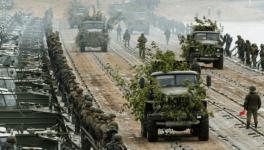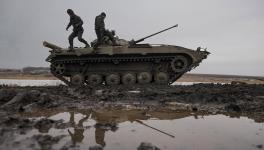Global Conflicts: Death Toll at Highest in 21st Century
A Wagner Group soldier guards an area outside apartment blocks in the city of Artyomovsk (Bakhmut).
Since the 21st century began, war has never cost humanity so much. The number of conflict deaths almost doubled in 2022 compared to the previous year. And war caused a 13% loss of global GDP, according to the Global Peace Index, released on Wednesday by the Institute for Economics and Peace (IEP).
The major new survey by the global think tank said that the average level of "global peacefulness" had sunk for the ninth year in a row, with conflict deaths topping the previous global peak reached in 2014 during the Syrian Civil War.
The dramatic increase in death rates was mostly driven by the war in Ukraine, where 83,000 people were killed in the past year, though the bloodiest conflict was in Ethiopia, where 100,000 people lost their lives.
Internationalized conflict
The Global Peace Index is put together evaluating almost every country in the world according to 23 indicators, broken down into three domains: "Ongoing Domestic and International Conflict," "Societal Safety and Security," and "Militarization," which reflect both social peace (crime statistics, the number of homicides) and a country's conflicts at home and abroad. Altogether, the average level of "global peacefulness," as measured by the index, had deteriorated by 0.42%.
The most obvious trend was that conflicts had become more internationalized, according to Steve Killelea, founder and executive chairman of the Institute for Economics and Peace (IEP), and one of the authors of the report. Ninety-one of the world's countries are now involved in some kind of conflict, the GPI found, compared to 58 in 2008.
"That's not necessarily a good or a bad thing," Killelea told DW. "Some might be involved in peacekeeping operations, like ECOWAS [Economic Community of West African States]. On the one hand, more countries are getting involved in wars overseas, but you could also say we're becoming more internationalized in how we're working together."
This might be seen as a surprising development, given that Western military intervention has been scaled back in the last decade. The US and NATO have now withdrawn from Iraq and Afghanistan, for example. But, as Killelea pointed out, the US is still involved in conflicts – it is now the biggest supporter of Ukraine.

'Wars are hard to win'
Killelea says that one thing that the new index shows is that "wars are really hard to win." The conflicts in Yemen and Syria have now been raging for 9 and 12 years respectively, and in neither is there any apparent prospect of a military victory.
"Even the best equipped militaries in the world find it difficult to beat a local population that doesn't want to be invaded and is well-resourced," said Killelea. That, according to Killelea, is down to the sophistication and availability of modern weaponry, which is making asymmetric warfare increasingly easy to continue. "Almost anyone with basic engineering training can now detonate bombs remotely, while guns have much more accuracy," he said.
The report also points out that the number of non-state groups using drones doubled between 2018 and 2022, and the total number of drone strikes nearly tripled over the same period.
The upshot of these trends is that war and peace both prove durable: Iceland remains the most peaceful country in the world, a position it has held on the index since 2008, while Afghanistan has now been ranked the world's least peaceful country for eight consecutive years. Similarly, Yemen, Syria, South Sudan, and the Democratic Republic of the Congo have all been among the ten least peaceful countries in the world since the index was launched in 2007.
And yet, Killelea insists there are larger, positive trends. "I think one of the more positive developments have been in the Middle East and North Africa — over the last three years, 13 countries have actually improved their peacefulness, and only 7 have deteriorated," he said. "There's now an established trend of improving peacefulness in the Middle East. So all the dynamics aren't necessarily bad."
This is particularly exemplified by Libya, which for the second year in a row has shown the biggest improvement in its peacefulness rating on the index. Although the security situation is still fragile in Libya, the ceasefire signed in 2020 between the Government of National Accord and the Libyan National Army has significantly stabilized the country.
Another positive note was that many countries have become safer internally: Several countries in the Caribbean and Central America, for example, recorded reductions in domestic terrorism and murder rates over the past year.

The price of war
One of the starkest findings of the report is the economic cost of war. In total, war and violence cost the world $17.5 trillion last year, or 12.9% of global GDP. For those countries most affected by conflict, the impact is obviously particularly devastating: Ukraine, for instance, spent 63% of its GDP on defense against the Russian invasion.
And the threat of future conflict is also startling: The report calculated that a potential Chinese blockade of Taiwan, for instance, would lead to a drop in global economic output equivalent to double the loss that occurred as a result of the 2008 global financial crisis.
Of course, many arms companies also make money from war, but according to the index, those economic gains are dwarfed by the expense that war and militarization brings. "If I build an aircraft carrier: That might cost me $20 billion to build, and $500 million a year to run the thing," said Killelea. "The best I can hope for is that I don't use it. But that money could be used for stimulating business, on the health system, where it would have a far more productive benefit for the economy."
Edited by: Peter Hille
Get the latest reports & analysis with people's perspective on Protests, movements & deep analytical videos, discussions of the current affairs in your Telegram app. Subscribe to NewsClick's Telegram channel & get Real-Time updates on stories, as they get published on our website.



















